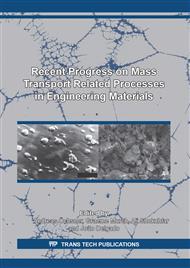[1]
ABNT, PN 02: 013.40-009 (2005), Gypsum blocks used for walls in buildings – Test methods, Rio de Janeiro, Brazil. (in Portuguese).
Google Scholar
[2]
ABNT, PN 02: 013.40-010 (2005), Gypsum blocks used for walls in buildings – Specifications, Rio de Janeiro, Brazil. (in Portuguese).
Google Scholar
[3]
ABNT, NBR 14081 (2005), Dry-set Portland cement mortars - Requirements, Brazil.
Google Scholar
[4]
ABNT, NBR 15575-4 (2013), Residential buildings - Performance Part 4: Requirements for internal and external wall systems– SVVIE, Brazil. (in Portuguese).
Google Scholar
[5]
A.C. Azevedo, J.M.P.Q. Delgado, A.S. Guimarães, F.A.N. Silva, R.A. Oliveira (2019), Compressive Strength Relation between Prisms, Wallets and Walls of Coated and Uncoated Clay Bricks. Revista de la Construcción - Journal of Construction, 18 (1), p.123–133.
DOI: 10.7764/rdlc.18.1.123
Google Scholar
[6]
J.M.P.Q. Delgado, N. Ramos, E. Barreira, V.P. De Freitas (2010). A critical review of hygrothermal models used in porous building materials. J. Porous Media, 13 (3), pp.221-234.
DOI: 10.1615/jpormedia.v13.i3.30
Google Scholar
[7]
J.M.P.Q. Delgado, N. Ramos, V.P. De Freitas (2006), Can moisture buffer performance be estimated from sorption kinetics?. Journal of Building Physics, 29 (4), pp.281-299.
DOI: 10.1177/1744259106062568
Google Scholar
[8]
V.P. De Freitas, A.S. Guimarães, J.M.P.Q. Delgado (2011), The Humivent, device for rising damp treatment. Recent Patents on Engineering, 5 (3), pp.233-240.
DOI: 10.2174/187221211797636863
Google Scholar
[9]
W.H. Gourdin, W.D. Kingery (1975), The Beginnings of Pyrotechnology: Neolithic and Egyptian Lime Plaster. Journal of Field Archaeology, Boston, v. 2, n. 1, pp.133-150.
DOI: 10.1179/009346975791491277
Google Scholar
[10]
F.M.C. Oliveira, L.E.P. Borges, E.B. Melo, M.L.S.C. Barros (2012), Mineralogical and crystallographic features of the gipsum in Araripe, Holos 5, p.71.
Google Scholar
[11]
R.A. Oliveira, F.A. Nogueira Silva, C.W.A. Pires Sobrinho, A.C. Azevedo, J.M.P.Q. Delgado, A.S. Guimarães (2018), Structural Performance of Unreinforced Masonry Elements Made with Concrete and Horizontally Perforated Ceramic Blocks – Laboratory Tests. Construction and Building Materials, 182, pp.20-34.
DOI: 10.1016/j.conbuildmat.2018.06.092
Google Scholar
[12]
Q. Wang, Y. Cui, J. Xue (2020), Study on the improvement of the waterproof and mechanical properties of hemihydrate phosphogypsum-based foam insulation materials. Construction and Building Materials, 230, article n. 17014.
DOI: 10.1016/j.conbuildmat.2019.117014
Google Scholar


